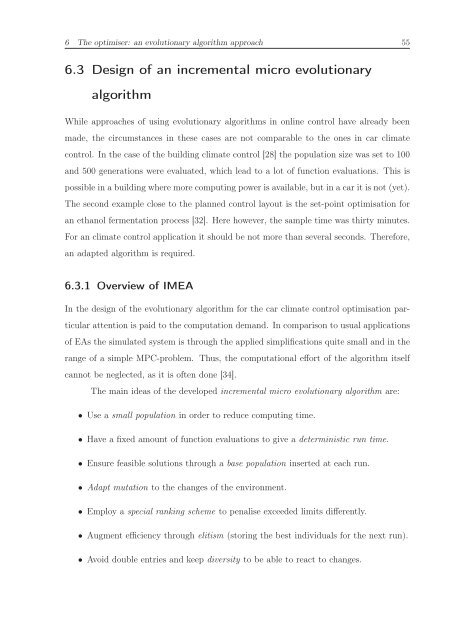Design of an Automatic Control Algorithm for Energy-Efficient ...
Design of an Automatic Control Algorithm for Energy-Efficient ...
Design of an Automatic Control Algorithm for Energy-Efficient ...
You also want an ePaper? Increase the reach of your titles
YUMPU automatically turns print PDFs into web optimized ePapers that Google loves.
6 The optimiser: <strong>an</strong> evolutionary algorithm approach 55<br />
6.3 <strong>Design</strong> <strong>of</strong> <strong>an</strong> incremental micro evolutionary<br />
algorithm<br />
While approaches <strong>of</strong> using evolutionary algorithms in online control have already been<br />
made, the circumst<strong>an</strong>ces in these cases are not comparable to the ones in car climate<br />
control. In the case <strong>of</strong> the building climate control [28] the population size was set to 100<br />
<strong>an</strong>d 500 generations were evaluated, which lead to a lot <strong>of</strong> function evaluations. This is<br />
possible in a building where more computing power is available, but in a car it is not (yet).<br />
The second example close to the pl<strong>an</strong>ned control layout is the set-point optimisation <strong>for</strong><br />
<strong>an</strong> eth<strong>an</strong>ol fermentation process [32]. Here however, the sample time was thirty minutes.<br />
For <strong>an</strong> climate control application it should be not more th<strong>an</strong> several seconds. There<strong>for</strong>e,<br />
<strong>an</strong> adapted algorithm is required.<br />
6.3.1 Overview <strong>of</strong> IMEA<br />
In the design <strong>of</strong> the evolutionary algorithm <strong>for</strong> the car climate control optimisation par-<br />
ticular attention is paid to the computation dem<strong>an</strong>d. In comparison to usual applications<br />
<strong>of</strong> EAs the simulated system is through the applied simplifications quite small <strong>an</strong>d in the<br />
r<strong>an</strong>ge <strong>of</strong> a simple MPC-problem. Thus, the computational ef<strong>for</strong>t <strong>of</strong> the algorithm itself<br />
c<strong>an</strong>not be neglected, as it is <strong>of</strong>ten done [34].<br />
The main ideas <strong>of</strong> the developed incremental micro evolutionary algorithm are:<br />
• Use a small population in order to reduce computing time.<br />
• Have a fixed amount <strong>of</strong> function evaluations to give a deterministic run time.<br />
• Ensure feasible solutions through a base population inserted at each run.<br />
• Adapt mutation to the ch<strong>an</strong>ges <strong>of</strong> the environment.<br />
• Employ a special r<strong>an</strong>king scheme to penalise exceeded limits differently.<br />
• Augment efficiency through elitism (storing the best individuals <strong>for</strong> the next run).<br />
• Avoid double entries <strong>an</strong>d keep diversity to be able to react to ch<strong>an</strong>ges.














